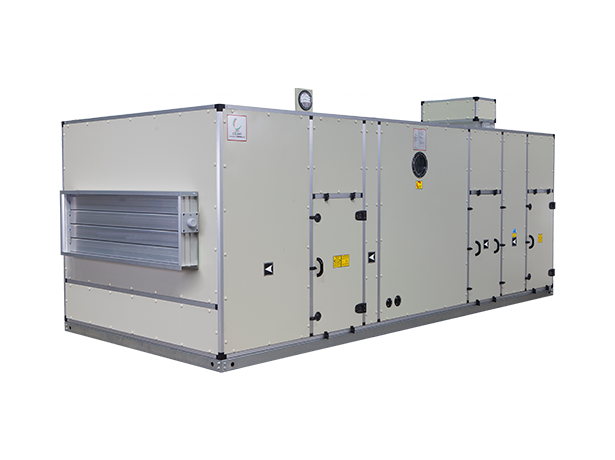Selecting the right AHU size is a cornerstone skill for every HVAC student, engineer, and designer. In today’s energy-conscious and performance-driven environment, Air Handling Unit (AHU) sizing goes beyond basic rules of thumb—it requires a deep understanding of thermodynamics, psychrometrics, airflow principles, and building science.
This in-depth guide is designed not only for professionals but especially for HVAC students who want to gain a solid foundation in how to select the right AHU size. It provides everything from fundamental concepts to advanced calculations, best practices, real-world examples, and tools to ensure you can make informed decisions in the field or during HVAC system design.
What Is an Air Handling Unit (AHU)?

An AHU is the heart of an HVAC system, responsible for conditioning (heating, cooling, humidifying, dehumidifying) and circulating air throughout a building. It consists of components such as fans (supply and return), filters, heating and cooling coils, dampers and mixing boxes, humidifiers, and sound attenuators.
AHUs can be classified into various types based on their design and application. These include single zone or multi-zone units, packaged or custom-built systems, and indoor or outdoor mounted units. Understanding its purpose and configuration is essential before attempting to size it correctly.
Why Proper AHU Sizing is Critical
Understanding how to select the right AHU size is crucial because AHU sizing impacts several key aspects of HVAC system performance. Firstly, it affects thermal comfort—an inadequately sized unit may struggle to maintain the desired indoor temperature. Secondly, it influences energy consumption, as oversized units tend to short cycle and waste energy. Additionally, indoor air quality is dependent on proper airflow and filtration, which must align with occupancy levels. Finally, correct sizing ensures a longer equipment life span, as improperly sized units can suffer from premature wear and tear.
For students: mastering this concept early prepares you for designing efficient HVAC systems in real projects.
Fundamentals of Airflow and Load Calculation
Understanding airflow and load calculation is a foundational step in how to select the right AHU size for any HVAC application. Accurate AHU sizing begins by calculating the heating and cooling demands of a building, which are split into two categories: sensible load and latent load. Sensible load refers to the heat that causes a change in air temperature, while latent load deals with moisture removal, crucial in humid climates. These loads must be carefully assessed using industry-standard methods like Manual J (for homes), Manual N (for commercial buildings), or advanced software such as Carrier HAP or Trane TRACE 3D Plus.

Once the load is calculated, the next step is determining the required airflow, usually expressed in CFM (Cubic Feet per Minute). CFM is a vital parameter that defines the volume of air the AHU must deliver to maintain indoor comfort. It can be calculated using the sensible heat equation:
CFM = BTU/hr ÷ (1.08 × ΔT)
where BTU/hr is the sensible cooling or heating load, 1.08 is a constant that includes air density and specific heat, and ΔT is the temperature difference between supply and return air.
For instance, in a scenario where the sensible cooling load is 60,000 BTU/hr and the temperature difference is 20°F, the airflow requirement would be:
CFM = 60,000 ÷ (1.08 × 20) = 2,778 CFM
To properly understand how to select the right AHU size, you must also factor in required ventilation rates, which are influenced by occupancy and local codes like ASHRAE Standard 62.1. Overlooking these can lead to poor indoor air quality and inefficient operation. Ultimately, mastering load and airflow calculations is not just about formulas; it’s about ensuring that your AHU selection meets comfort, efficiency, and regulatory goals.
In summary, mastering airflow and load calculation forms the core of AHU sizing. It bridges theory with application, ensuring that future HVAC designers and students can develop energy-efficient, high-performance systems tailored to specific building needs.
Factors Influencing AHU Sizing
Several factors play a role in determining the correct AHU size. The occupancy load contributes to internal heat gains and CO2 levels. The type of equipment used within the space, such as computers or lighting, adds to the internal heat gain. The building envelope characteristics—including insulation levels, window types, and solar shading—directly affect the heating and cooling load.
Air change requirements differ based on the building application; for instance, laboratories or healthcare settings require more frequent air changes. The climate zone determines the outdoor conditions to design against. Ductwork design influences the external static pressure that the AHU must overcome. Additionally, the required filtration level (e.g., MERV ratings) and acoustical performance will also influence the final selection.
Step-by-Step AHU Sizing Process
Start by conducting a comprehensive load calculation using reliable software or manual methods. This helps you determine the building’s total cooling and heating loads, including both sensible and latent components—an essential first step in understanding how to select the right AHU size effectively.
Next, calculate the supply air flow in cubic feet per minute (CFM) using the sensible heat equation. This tells you how much air must be moved to handle the space’s cooling or heating load. Then, add the required outdoor ventilation air based on ASHRAE 62.1 standards, which often depends on occupancy and floor area.
Once you’ve determined total airflow, evaluate the total static pressure that the fan must overcome. This includes pressure drops from filters, coils, ductwork, diffusers, and other components. You can then calculate the required brake horsepower (BHP) for the fan motor.

Now select coils (cooling and/or heating) that can handle the design loads at the selected air flow rate. The coil selection must match the entering and leaving air conditions, as well as the fluid properties if using chilled water or hot water.
Finally, select a fan and motor combination that can deliver the desired airflow against the total static pressure while staying within acceptable noise and energy limits. Confirm the fan curve and motor efficiency before finalizing the design. These detailed steps are the foundation of mastering how to select the right AHU size for any HVAC application.
Real-World Sizing Example
Application: Lecture Hall in a University
- Area: 3,000 ft²
- Occupancy: 150 people
- Location: Hot-humid (e.g., Chennai, India)
- Cooling Load: 300,000 BTU/hr (Sensible 240,000, Latent 60,000)
- ΔT: 20°F
Step 1: CFM for Sensible Load
CFM = 240,000 ÷ (1.08 × 20) = 11,111 CFM
Step 2: Add Ventilation (15%)
Final CFM = 11,111 × 1.15 ≈ 12,778 CFM
Step 3: Static Pressure Estimate Total pressure drop from ductwork, coils, and filters is approximately 2.25 in WG.
Step 4: Select Fan & Motor Use manufacturer software to select a fan that meets 12,778 CFM at 2.25″ static pressure.
Step 5: Coil Selection Select a chilled water coil capable of handling approximately 300 MBH.
Tools and Software for Sizing AHUs
HVAC students should get hands-on experience with tools such as Carrier HAP (for load and AHU design), Trane TRACE 3D Plus (for energy modeling), Greenheck CAPS (for AHU configuration), Elite RHVAC (for residential HVAC), and various online psychrometric calculators. These tools not only help in sizing but also in component selection and energy efficiency evaluation.
Psychrometrics in AHU Sizing
Psychrometrics is essential in AHU sizing. You need to plot supply and return air conditions, determine the sensible heat ratio, locate mixed air points, and confirm dew point and relative humidity levels.

For students, tracing the sensible and latent heat processes on psychrometric charts using color coding can significantly improve understanding. Regular practice with these charts sharpens the ability to interpret and design AHU systems effectively.
Mistakes to Avoid
Avoid relying solely on general rules of thumb, such as fixed CFM per square foot. Always account for both sensible and latent loads—especially in humid climates. Overlooking ventilation air requirements or ignoring pressure drops across filters and coils can lead to underperformance. Finally, avoid the temptation to oversize equipment to “be safe”—this leads to inefficiency, short cycling, and comfort issues.
Tips for Students & Future HVAC Designers
Start by mastering manual calculation methods to build conceptual strength—this foundational knowledge is essential for understanding how to select the right AHU size accurately. It also helps you better interpret software outputs when you move on to digital tools. Study psychrometric charts until you can intuitively plot and analyze air properties under different conditions. Dive deep into ASHRAE Standards, particularly 62.1 (ventilation), 90.1 (energy), and 55 (thermal comfort), as they directly influence AHU design criteria. Seek out internships or work on real-world case studies where you can apply your learning. Join HVAC forums and LinkedIn groups to connect with professionals and stay updated with industry best practices.
Final Words and Further Learning Resources
Learning how to select the right AHU size is more than just memorizing formulas—it’s a comprehensive process that blends science and practical engineering. It requires integrating thermodynamics, airflow principles, real-world constraints, and building science into one well-coordinated system. For HVAC students and professionals alike, understanding how to select the right AHU size is essential, whether you’re designing for thermal comfort, process control, or critical environments like healthcare facilities. At the core of every efficient HVAC system lies proper AHU sizing.
Recommended Books:
- ASHRAE Handbook – Fundamentals (2021)
- “HVAC Fundamentals” by Samuel Sugarman
- “Mechanical and Electrical Equipment for Buildings” by Grondzik & Kwok


